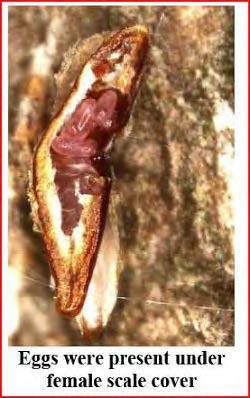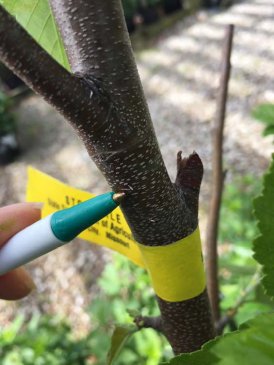AgEBB-MU CAFNR Extension
Green Horizons
Volume 23, Number 3
Fall 2019
Pest Patrol
The Weight of the Scale - Japanese Maple Scale Attacking Missouri's Trees
By Sarah Phipps | Missouri Department of Agriculture
Shipments of oyster-shell shaped insects are being brought to Missouri on nursery trees. Unfortunately, instead of a pearl, an exotic, plant-thirsty, armored scale called the Japanese Maple Scale (Lopholeucaspis japonica) resides underneath the protective waxy covering. They can be hard to spot since outwardly they don't look like an insect at all. Lacking the typical traits of six legs, wings and wiggly antennae, they are a motionless, legless bead that attaches onto the trunk and branches. Looking at a single scale - it doesn't appear that they possess the capacity to create a nuisance, but they are continuously feeding on the plant's nutrients that flows just beneath the bark with their piercing sucking mouthparts. Strength in numbers make this minute insect a formidable pest that will instigate twig and branch dieback, thinning canopy, and a gradual decline in the health of trees and shrubs.
 |
Photo of Japanese Maple Scale Eggs (note the purple color) Image from the University of Delaware Cooperative Extension |
Unlike its name, Japanese Maple Scale (JMS) feeds on more than just the Japanese maple. In fact, they are not picky eaters as the scale's known host range includes trees and shrubs in more than 45 genera in 27 families. It infests many of the most common nursery and landscape plants in Missouri including red maple, lilac, dogwood, redbud, pear, crabapple, cherry, magnolia, hornbeam, honey locust, stone fruits, birch and broadleaf evergreens like holly and firethorn. It initially arrived on the east coast, but is rapidly expanding its range with the help of infested nursery stock. JMS was first observed in Missouri in 2013 on some hornbeams that were direct shipped to St. Louis from a nursery in Tennessee. However, it is being found more commonly in nurseries all over the state as many more shipments of infested plants are being received. Missouri Department of Agriculture inspectors look for and stop sale infested plants, but you should be on the lookout for this pest as well.Japanese Maple Scales' wide host range is not the only challenge of this emerging pest. Since armored scales are typically small and blend well with the plant bark, they are frequently overlooked. Because of this, scouting for the pest is an essential step to spot the scale when the population is low.
Inspection tips include scanning the bark closely, especially at branch collars and along the trunk. Light infestations often start in the cracks and rough areas of the bark and branches. Look on bark for the small white, elongated, narrow scale covers measuring only 1-2 mm long. They can blend in with the whitish lenticels and can be easily glossed over without close inspection. In a light infestation, it can be easy to miss at first as it can just be in one small portion of the tree. A hand lens would be helpful in this endeavor. To test if it's Japanese Maple Scale, use your thumbnail to lightly scratch off the outer wax covering which will expose the purplish, soft- bodied insect or eggs underneath. Heavy populations can cover tree trunks and branches and appear as a coating of white flecks. MDA nursery inspector, Susan Ehlenbeck, notes that there are a few scale insects that can be confused with JMS including the White Peach Scale (can get on ash and a few other deciduous trees), White Pine Scale (looks similar, but usually on different hosts and JMS is smaller), Euonymus scale, and the grey race of Oystershell Scale (larger and easier to see than JMS).
 |
Japanese Maple Scale (located at the tip of pen point) on river birch found at a Missouri nursery. Close examination is required as the scale can blend in with the bark lenticels and crevices. Photo credit: Catherine Smith, Missouri Department of Agriculture. |
Their complex lifecycle makes it difficult to predict the perfect timing for pesticide application. Eggs are laid underneath the scale covering of the adult female. When the eggs hatch, tiny immatures, known as nymphs, emerge. During the "crawler" phase, nymphs have functional legs that they use to "crawl" to new areas on the plant or to another plant until they find a suitable location to settle in and start feeding. The "crawler" phase is the most vulnerable stage of their lifecycle, therefore it is the stage often targeted for control with contact pesticides. However, once the crawlers have settled down to feed, they create their protective covering and contact insecticides are largely ineffective. Treatment timing is challenging for JMS due to the fact that the crawler phase is extended throughout the season and their protective waxy covering is laid down in two to three days after feeding is initiated. We suspect that there are two generations of JMS a year, producing crawlers in two peak seasons. More studies are needed, but we suspect that the timing of the emergence of the crawlers will be similar to Tennessee (mid- to late spring and late summer emergences). Closely monitor for crawlers during the spring and summer months with the usage of sticky traps to help aid proper application timing.
If scouting reveals that JMS is present, keep in mind that this is not a one-treatment pest. Good results have been seen with using a combination of different treatment types, such as dormant oil, insect growth regulators and systemic insecticides. Dormant applications of horticultural oil is a treatment option which should be applied at 2% rate in the fall after leaves drop, or in spring before bud break. In fall or spring, apply when temperatures are above 50-60℉ for four to five days. Application of fall dormant oil helps to loosen the scale covers before winter which should increase winter mortality. Be careful of using oil as it can burn plants and some plants are more susceptible to burning (maples, redbud, etc.). When first instar crawlers are present and at peak activity, an insect growth regulator (IGR) can be applied. IGRs prevent the crawlers from developing, resulting in death of the insect. Soil-applied systemic insecticides such as imidacloprid has been shown effective with combination of other treatment types.
More information about the Japanese Maple Scale can be found at:
http://www.tnstate.edu/extension/documents/Japanese_Maple_Scale_in_the_Nursery.pdf
https://www.extension.umd.edu/sites/extension.umd.edu/files/_docs/programs/ipmnet/JapaneseMapleScale-UMD-1.pdf
